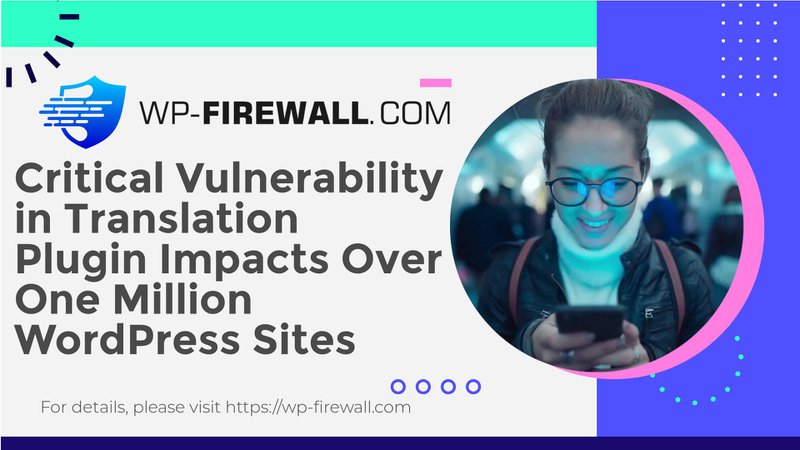
Understanding the Recent WordPress Translation Plugin Vulnerability: A Security Perspective
Introduction
The WordPress ecosystem is vast and dynamic, with millions of websites relying on various plugins to enhance functionality and user experience. However, this reliance on third-party plugins can expose sites to vulnerabilities, as highlighted by a recent report on a significant security flaw in a popular WordPress translation plugin that affects over one million sites. In this article, we will delve into the details of this vulnerability, its implications for website security, and how you can protect your WordPress site from similar threats.
The Vulnerability Unveiled
According to the report from Search Engine Journal, the vulnerability in question stems from a widely used translation plugin that allows website owners to offer multilingual content. The flaw was identified as a potential remote code execution (RCE) vulnerability, which means that attackers could exploit it to execute arbitrary code on the affected sites. This type of vulnerability is particularly concerning because it can lead to full site compromise, data breaches, and unauthorized access to sensitive information.
What is Remote Code Execution?
Remote Code Execution is a type of security vulnerability that allows an attacker to run malicious code on a target system from a remote location. This can lead to various malicious activities, including:
- Data Theft: Accessing and stealing sensitive user data, such as personal information and payment details.
- Site Defacement: Altering the website's appearance or content to mislead visitors or promote malicious activities.
- Malware Distribution: Using the compromised site to distribute malware to unsuspecting visitors.
Implications for WordPress Users
The discovery of such a vulnerability in a widely used plugin serves as a stark reminder of the potential risks associated with third-party software. For WordPress users, this incident highlights several critical considerations:
1. The Importance of Regular Updates
One of the most effective ways to mitigate the risk of vulnerabilities is to ensure that all plugins, themes, and the WordPress core are regularly updated. Developers frequently release updates to patch security flaws, and failing to apply these updates can leave your site exposed to known threats.
2. Choosing Plugins Wisely
Not all plugins are created equal. When selecting plugins for your WordPress site, consider the following:
- Reputation: Look for plugins with positive reviews and a solid reputation within the WordPress community.
- Active Development: Choose plugins that are actively maintained and updated by their developers.
- Security Audits: Consider plugins that have undergone security audits or have a history of prompt vulnerability disclosures.
3. Implementing Security Best Practices
In addition to keeping plugins updated, website owners should adopt a comprehensive security strategy that includes:
- Regular Backups: Maintain regular backups of your website to ensure you can quickly restore it in the event of a compromise.
- User Access Control: Limit user access to only those who need it, and regularly review user permissions.
- Strong Passwords and Two-Factor Authentication: Enforce strong password policies and consider implementing two-factor authentication for added security.
The Role of Web Application Firewalls (WAF)
A Web Application Firewall (WAF) can be an invaluable tool in protecting your WordPress site from vulnerabilities like the one discussed. A WAF acts as a shield between your website and potential threats, filtering out malicious traffic before it reaches your site.
Benefits of Using a WAF
- Real-Time Threat Detection: A WAF can identify and block suspicious activity in real-time, preventing attacks before they can cause harm.
- Protection Against OWASP Top 10 Vulnerabilities: A robust WAF is designed to mitigate the most common web application vulnerabilities outlined by OWASP, including SQL injection, cross-site scripting (XSS), and more.
- Reduced Server Load: By filtering out malicious requests, a WAF can help improve your website's performance and reduce server load.
Case Study: The Impact of the Vulnerability
To understand the real-world implications of such vulnerabilities, consider a hypothetical scenario involving a small e-commerce site using the affected translation plugin. Upon discovering the vulnerability, the site owner neglected to update the plugin, leading to a successful attack by a malicious actor.
Consequences of the Attack
- Data Breach: The attacker gained access to customer data, including names, addresses, and payment information.
- Reputation Damage: Customers lost trust in the site, leading to decreased sales and negative reviews.
- Financial Loss: The site owner faced potential legal repercussions and costs associated with remediation and recovery.
This scenario underscores the importance of proactive security measures and the need for website owners to stay informed about potential threats.
How to Protect Your WordPress Site
1. Stay Informed
Regularly monitor security news and updates related to WordPress plugins and themes. Subscribe to security newsletters and follow reputable sources to stay informed about the latest vulnerabilities and best practices.
2. Conduct Regular Security Audits
Perform regular security audits of your website to identify potential vulnerabilities. This can include checking for outdated plugins, weak passwords, and misconfigured settings.
3. Utilize Security Plugins
In addition to a WAF, consider using security plugins that offer features such as malware scanning, login protection, and firewall capabilities. These tools can provide an additional layer of security for your WordPress site.
4. Educate Your Team
If you have a team managing your WordPress site, ensure they are educated about security best practices. Conduct training sessions to raise awareness about common threats and how to mitigate them.
Conclusion
The recent vulnerability in a popular WordPress translation plugin serves as a critical reminder of the importance of website security. By staying informed, implementing best practices, and utilizing security solutions, you can significantly reduce the risk of compromise and protect your WordPress site from potential threats.
Take Action Now
To ensure your WordPress site remains secure, consider signing up for the free plan of WP-Firewall. Our comprehensive security solutions are designed to protect your website from vulnerabilities like the one discussed in this article. Don’t wait until it’s too late—secure your site today by visiting WP-Firewall Free Plan.
Citations:
[1] https://wp-firewall.com
[2] https://www.searchenginejournal.com/wordpress-translation-plugin-vulnerability-affects-1-millio

